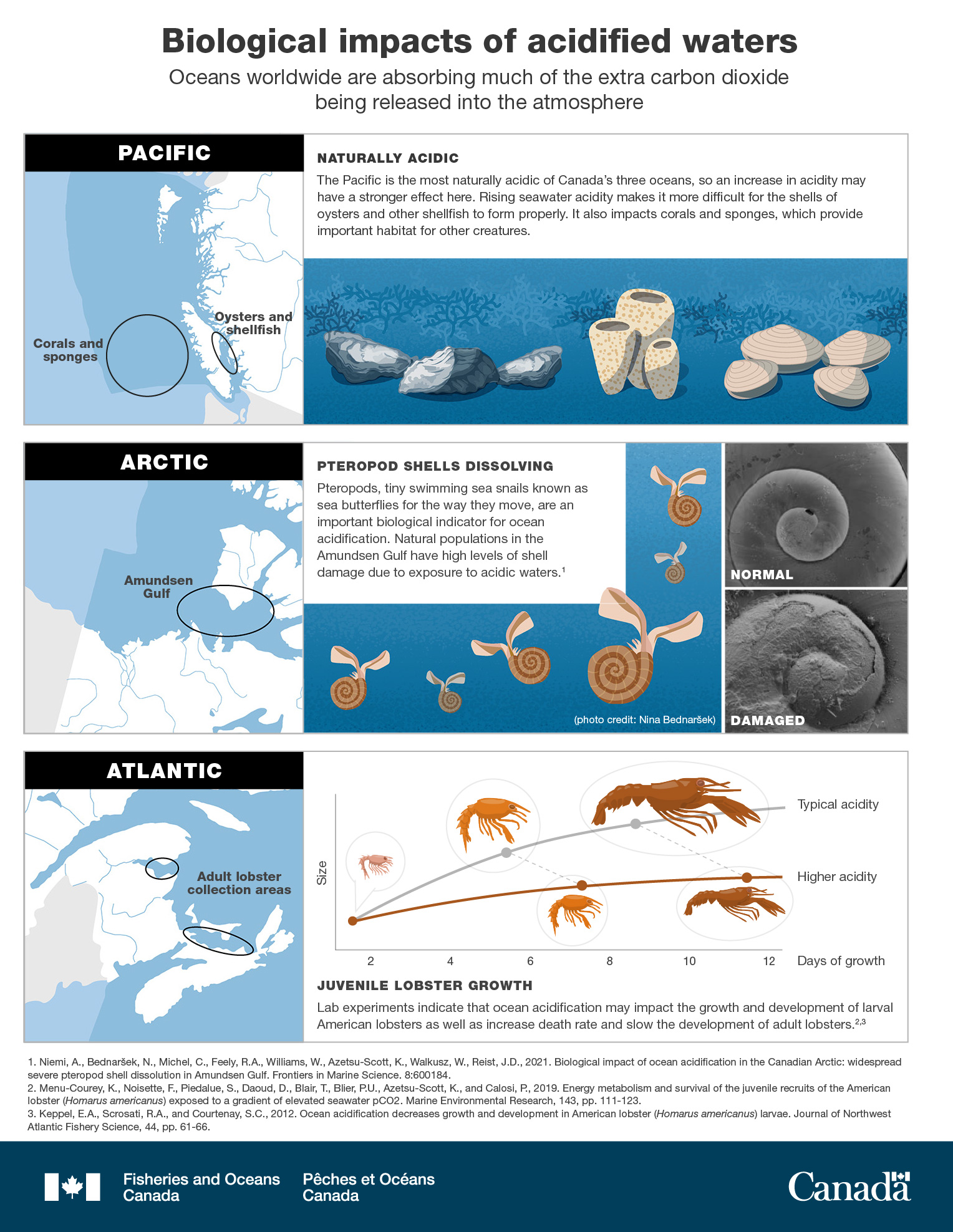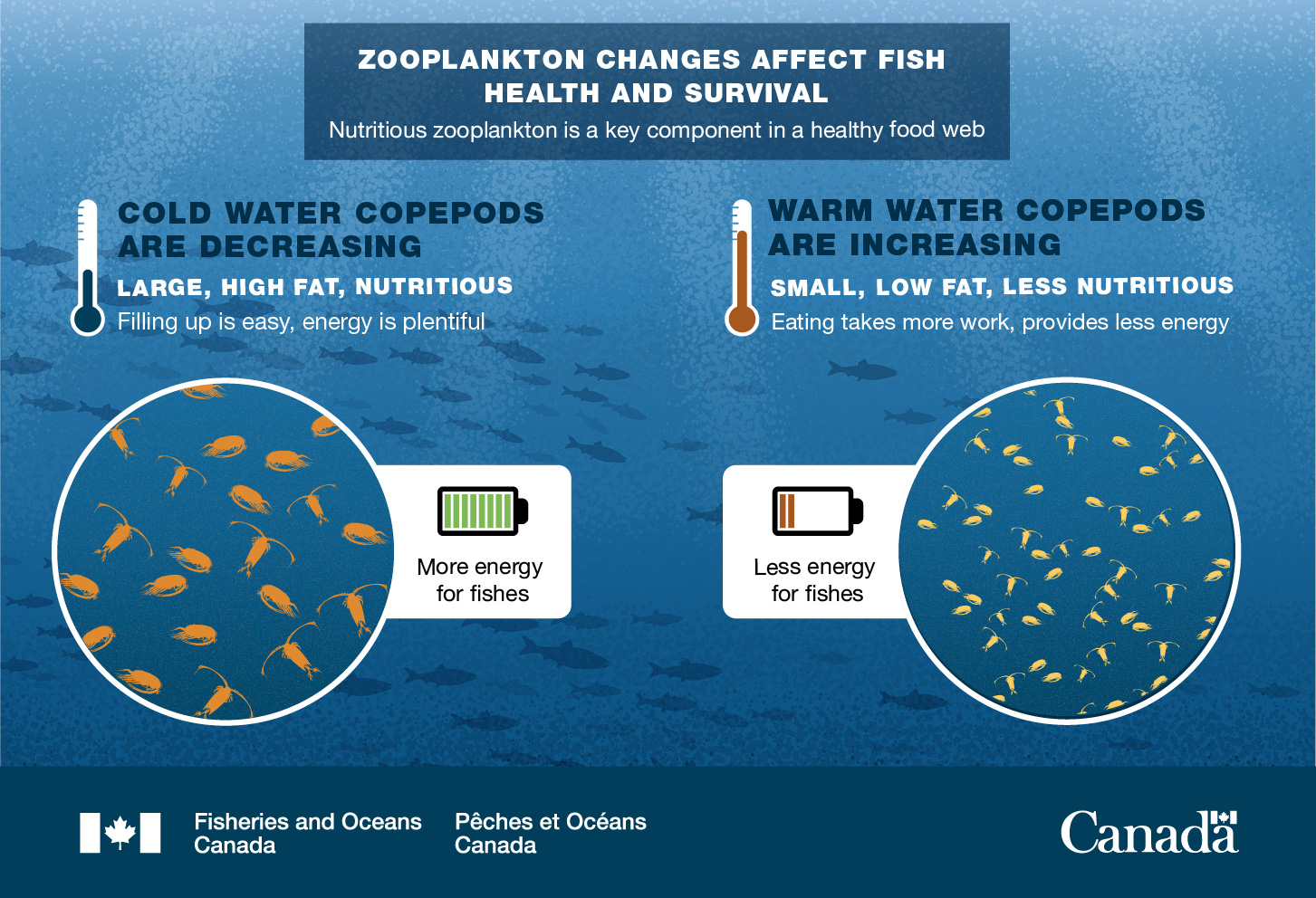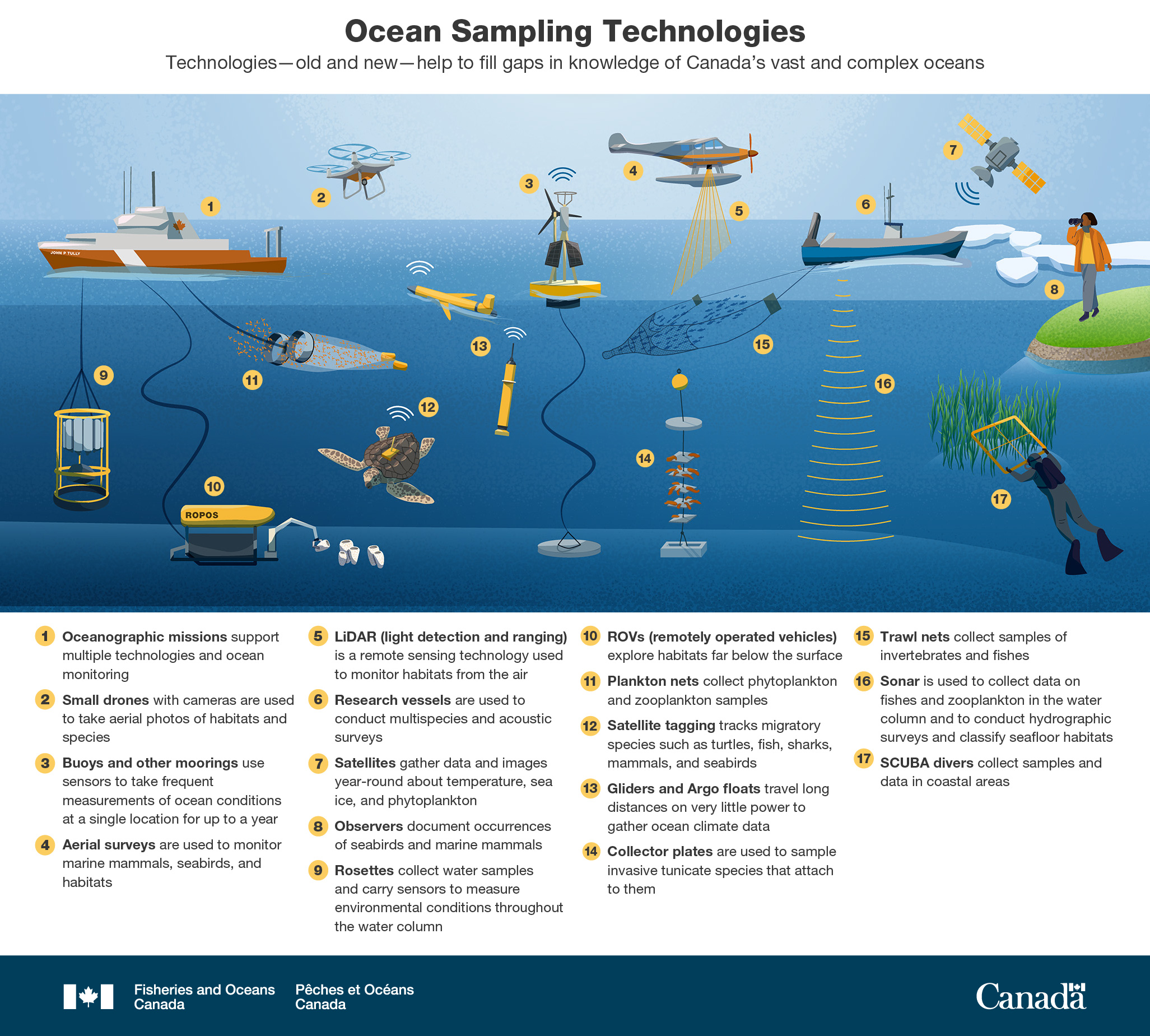Canada’s Oceans Now, 2020
On this page
Foreword
As part of the Government of Canada’s ongoing commitment to inform its citizens on the current state of its oceans, Fisheries and Oceans Canada produces a series of reports entitled Canada’s Oceans Now. Each four-year series features an annual report summarizing the current status and trends for the Pacific, Atlantic, and Arctic oceans followed by a national synthesis. Reports provide highlights and examples of the multitude of influences and changes affecting these dynamic ocean systems.
Canada’s Oceans Now, 2020 is a national review and update of Canada’s three oceans based on previous technical and public reports for the Pacific, the Atlantic, and the Arctic Oceans. New knowledge was also incorporated based on updated information. Scientific research was conducted principally by Fisheries and Oceans Canada and Environment and Climate Change Canada (seabirds); some information was also based on community and Indigenous knowledge and work by universities and non-governmental organizations.
Citations
Technical reports
Bernier, R.Y., Jamieson, R.E., and Moore, A.M. (eds.) 2018. State of the Atlantic Ocean Synthesis Report. Can. Tech. Rep. Fish. Aquat. Sci. 3167: iii + 149 p.
Boldt, J.L., Javorski, A., and Chandler, P.C. (Eds.). 2020. State of the physical, biological and selected fishery resources of Pacific Canadian marine ecosystems in 2019. Can. Tech. Rep. Fish. Aquat. Sci. 3377: x + 288 p.
Niemi, A., Ferguson, S., Hedges, K., Melling, H., Michel, C., et al. 2019. State of Canada’s Arctic Seas. Can. Tech. Rep. Fish. Aquat. Sci. 3344: xv + 189 p.
Public reports
Canada’s Oceans Now: Atlantic Ecosystems, 2018.
Canada’s Oceans Now: Arctic Ecosystems, 2019.
Canada’s connected oceans
Our nation is a steward of the unique ecosystems and wealth of biodiversity that exists off our coastlines.
With marine waters spanning its west, north, and east coasts, Canada is an ocean nation. Canadians are influenced in many ways by the Pacific, Arctic, and Atlantic Oceans. Our three bordering and connected oceans support a bounty of habitats, plants, and animals, and play a key role in our economy, culture, identity, health and well-being (See All Canadians are connected to the oceans). While humans have collected ocean observations for centuries, there is still much to learn about Canada’s oceans. Today, new technologies are used alongside Indigenous and local knowledge to further understand marine ecosystems and how they are changing. Complex issues, such as the behaviour and status of migratory species that move between oceans, are better addressed when researchers from different disciplines, organizations, or countries collaborate (See Marine animals without borders).
The waters surrounding Canada are constantly moving (Figure 1: The ins and outs of Canada’s oceans). On the west coast, Pacific waters flow into the Arctic, bringing waters that are naturally acidic northward. On the east coast, the cool Labrador Current brings water south from the Arctic over the Newfoundland and Labrador Shelves, while the Scotian Slope is warmed by the Gulf Stream as it flows northward. Closer to Canada’s coastal communities, the ebb and flow of tides uncover shallow habitats such as mud flats and rocky shores, while altering shorelines through the erosion and deposit of sediments. The intertwining networks of inland lakes, streams, and rivers connect geographic locations across the country and also bring freshwater to the ocean. For example, the St. Lawrence River flows from Lake Ontario into the Gulf of St. Lawrence creating a vast and productive estuarine environment as large amounts of freshwater are brought to the Atlantic Ocean.
An incredible diversity of species and habitats exist in the unique ecosystems of Canada’s marine waters. Off Canada’s west coast, hundreds of deep sea hydrothermal vents spew super-heated gases up from the Pacific Ocean’s seafloor. On the Juan de Fuca Ridge, vents host around 60 different species, 12 of which do not exist anywhere else in the world. Up north in the high Arctic, the newly designated Tuvaijuittuq Marine Protected Area (MPA) has some of the oldest and thickest sea ice in Canada. Old ice from other Arctic waters can collect there, making it a summertime sea ice preserve and a home for the many species that rely on sea ice to survive. Out east, Atlantic Canada’s Bay of Fundy has the highest tides in the world, and its powerful currents stir up the nutrients needed for plankton growth, making it a hotspot for biodiversity that includes whales, fishes, bottom-dwellers and seabirds.
Canada’s oceans are also connected by change. Our oceans have all experienced pronounced physical and biological changes in recent years due to climate change and human activity—temperatures are rising; habitats are degrading; species distributions are shifting; and food webs are being transformed. In this National State of the Ocean report, common and unique observations and trends were noted in Canada’s three oceans for ocean climate, habitats, species, and food webs.
Sidebar: All Canadians are connected to the oceans
Canada has the longest coastline of any country in the world, and the ocean is deeply integrated into the lives of all Canadians.
A connection to the ocean is a natural part of human life. We are drawn to the ocean for its complexity, diversity, spiritual significance, beauty and beyond. Canada’s oceans support important aspects of ocial and cultural identity, especially among Indigenous and coastal communities.
Oceans provide natural services to life on Earth as they make clean air and water. They provide food security through recreational, subsistence, and commercial harvesting of marine plants and animals—feeding communities and countries near and abroad.
Canada’s three oceans support livelihoods through fisheries, aquaculture, shipping, energy production, travel and tourism industries. They’re an efficient method of travel for local movement and for transport of economic goods across the world. Ocean recreation provides a place for many leisure activities on or near the water—from dive trips to kayaking adventures and sailing to fishing.
Given the close linkages between our oceans and human wellbeing, it is not surprising Canadians also have a strong interest in ocean stewardship. In particular, balancing how we use the ocean so that it is healthy and continues to benefit people has been a longstanding driver for focused ocean research and education in Canada.
Spotlight: Marine animals without borders
Many marine animals move from ocean to ocean and cross international borders to find plentiful feeding grounds, a preferred water temperature, or to complete a portion of their lifecycle. Studying these animals means working together across regions and countries.
Leatherback and loggerhead turtles are found in Atlantic Canada throughout the summer and fall seasons, where they forage in warm offshore waters influenced by the Gulf Stream. They migrate to this area from southern nesting sites that are found in over a dozen countries in South America, the Caribbean, and the southeastern United States.
Some migratory marine mammals, such as Atlantic walrus, narwhals, and harp and hooded seals, migrate southward from the Arctic into Atlantic waters for part of the year to give birth (or pup) and feed. Beluga that feed and give birth in the western Canadian Arctic exit westward in the fall, transiting to American and Russian Arctic waters.
Even species that live near the seafloor will cross borders. Pacific hake is the most abundant groundfish (fish that live and feed on or near the seafloor) in the northeast Pacific Ocean. Each year coastal populations migrate from deeper waters of northern California to the shallower waters of the continental shelf break and inshore Vancouver Island to feed. They travel north along the British Columbia coast, as far as southern Alaska in some years. In the Arctic, Greenland halibut were recently found to travel all the way from Baffin Bay, Nunavut to the Grand Banks of Newfoundland, as well as to the west coast of Iceland.
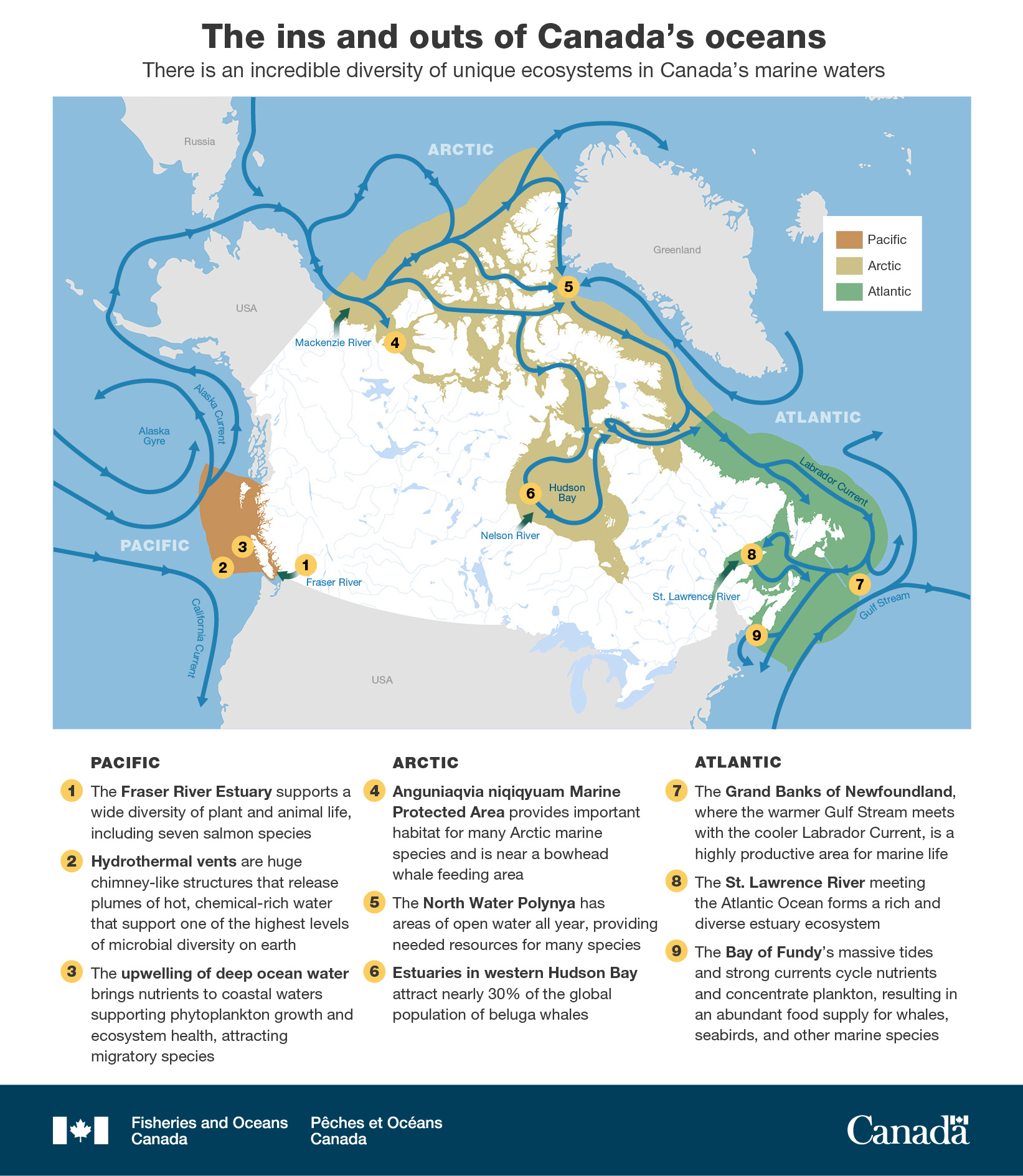
Figure 1: Major currents connecting—and some unique features of—Canada's Pacific, Arctic, and Atlantic oceans. The yellow numbered circles highlight a few areas of significance for each ocean.
Ocean climate
Canada’s oceans have become warmer, more acidic, and less oxygenated due to climate change.
Canada’s oceans are closely connected to the atmosphere and the global climate. Oceans are affected by seasonal and year-to-year climate variability as well as long-term climate change. Increasing levels of greenhouse gases in the atmosphere cause global temperatures to increase. As Canada’s oceans absorb this heat and carbon dioxide, they become warmer and more acidic, oxygen levels drop, summer sea ice in the Arctic decreases, and marine heatwaves become more frequent. Ocean currents and mixing redistribute the heat and carbon dioxide absorbed at the sea surface to deeper waters causing further changes to marine ecosystems that can be expected to last for decades.
Ocean temperature
Heat from the sun warms ocean surface waters and mixing transfers this heat into deeper water layers. As a result of climate change, water temperatures are fluctuating in unprecedented ways from ocean surface to seafloor. Changing water temperatures can also affect the distribution, growth, and life cycles of plants and animals—and the availability and timing of food sources in marine ecosystems.
State of Canada’s oceans
All of Canada’s oceans are warming and sea surface temperatures are rising by close to 1°C per century. However, summer surface waters in some areas of the Arctic have warmed as rapidly as 1°C per decade over the last 20 years. Warmer seasonal temperatures in deeper waters and more frequent marine heatwaves are being observed. These increasing ocean temperatures are affecting entire ecosystems—favourable for some species but unfavourable for others.
In the Pacific
Canada’s Pacific Ocean shows a long-term trend of ocean warming. Daily sea surface temperatures collected along the coast of British Columbia over the past 80 years show coastal waters have warmed about 0.7°C. In the northeast Pacific, marine heatwaves have become more frequent. One multi-year marine heatwave from 2014 to 2016—called “the Blob”—saw sea surface temperatures reach more than 3°C above seasonal averages. Such extended warm conditions have not been seen in this region since record-keeping began. In the summer of 2019, a similar marine heatwave occurred in the same area, but since then Pacific sea surface temperatures have been returning to the 30-year average.In the Arctic
Average summer (August) sea surface temperatures have been 1°C to 4°C higher than normal in the Beaufort Sea, Baffin Bay, and the Canadian High Arctic in recent years. However, in winter when the ocean is ice covered, sea surface temperature has not changed. Loss of summer sea ice is allowing sea surface temperature to rise more quickly in response to surface air temperatures. Air temperatures in the Arctic as a whole are warming at twice the global average. Increasing air and ocean temperature is also thawing frozen ground across the Canadian Arctic and causing coastal areas to collapse and erode into the ocean.In the Atlantic
For sea surface temperature, two of the five warmest years since satellite records began in 1985 were recorded in 2012 (warmest) and 2014 (fourth warmest). The Newfoundland and Labrador Shelves had overall above-average bottom temperatures between 2012 and 2016. Increasing contribution of warmer water from the Gulf Stream has also led to successive 100-year-record high temperatures in the northern Gulf of St. Lawrence.
Sea ice
In the Atlantic and Arctic oceans, entire marine ecosystems are influenced by the presence and movement of sea ice. In the Arctic, sea ice is the most influential feature of the ocean environment; entire marine ecosystems are changing as sea ice is altered by climate change. Sea ice affects livelihoods along the Arctic and Atlantic coasts and is integral to Inuit culture. It acts as an ice highway and connects communities to both ocean resources and one another. As sea ice continues to change, its influence on the climate has far reaching effects both locally and globally.
State of Canada’s oceans
Across Canada, there is a reduction in the amount and thickness of sea ice as well as a shorter sea ice season. The location, stability, and timing of sea ice areas has become less predictable. Much of the remaining old sea ice is concentrated in the northernmost part of Canada’s Arctic, making it a unique refuge for ice-associated ecosystems and species.In the Arctic
Sea ice in the Arctic is melting earlier and forming later, leading to a longer open water period that is altering how the ecosystems function and species interact. Within Canadian Arctic waters, much of the old ice (having survived summer and winter periods) still remains around the islands of Nunavut and the Northwest Territories, making Canada one of the last remaining homes for this shrinking sea ice habitat.
In the Atlantic
Atlantic waters are experiencing a loss of sea ice cover. Warmer winters since the late 1800s have led to less ice and longer ice-free periods. During the past decade, the amount of ice on the Newfoundland and Labrador Shelves, the Gulf of St. Lawrence, and the Scotian Shelf has been lower than average in most years. Record low amounts of ice were observed in the Gulf of St. Lawrence in 2010 and on the Newfoundland and Labrador Shelves in 2011.
Water movement
Water movements in Canada’s oceans are complex. Atmospheric patterns vary over time and naturally alter how ocean waters move. Ocean water moves both horizontally (ocean currents) and vertically through the water column (Figure 2: Upwelling). These movements are influenced by how oceans interact with the atmosphere and sea ice. As climate changes, the movement of ocean waters can be affected; this includes changes in patterns of upwelling, currents, vertical stability of ocean layers (stratification), and sea level (See Figure 3: Sea levels are changing). The water circulation patterns shown in Figure 1 provide a generalized representation of ocean surface currents around Canada.
State of Canada’s oceans
Increasing temperatures, increasing freshwater runoff, and decreasing sea ice are changing the circulation patterns of Canada’s oceans. Warmer surface water is leading to less vertical mixing with deeper ocean layers, affecting energy and oxygen supply to ocean food webs. A rise in global sea level is impacting coastal areas in Canada.
In the Pacific
The summer upwelling season in the Pacific has started earlier since 2005 but is not resulting in greater primary productivity of the ecosystem. Along the coasts, the flow of freshwater from the Fraser River into the ocean has been increasing over the last 100 years. Peak flow of the Fraser River is also occurring earlier in the year, though it is uncertain what influence these changes may have on nearby ecosystems. Tidal currents also contribute significantly to the circulation of many coastal inlets and fjords in British Columbia but are not directly affected by climate change.
In the Arctic
Upwelling in coastal waters has increased in the western part of the Canadian Arctic due to a sustained clockwise rotation of surface water far offshore. In the offshore, the ocean has become more resistant to mixing as stratification has been strengthened by the buildup of freshwater and by sea surface warming of ice-free areas in summer. Changes in storms and winds are also having greater effects on shorelines as storm waves are less impeded by sea ice.
In the Atlantic
Increased stratification in the Atlantic, which reduces the mixing of surface and deep waters, has been linked to warmer sea surface temperatures and increased freshwater runoff. The water entering the Gulf of St. Lawrence is formed by a mix of the Gulf Stream waters from the south and the Labrador waters from the north. In recent years, the warmer Gulf Steam has had a larger influence than the cooler Labrador Current, leading to waters of higher temperature and lower oxygen concentrations, which is changing the habitat conditions in the deeper portions of the Gulf of St. Lawrence. Sea level rise is variable across the Atlantic, with levels falling in some areas (2 mm per year) and rising in others (2–4 mm per year).
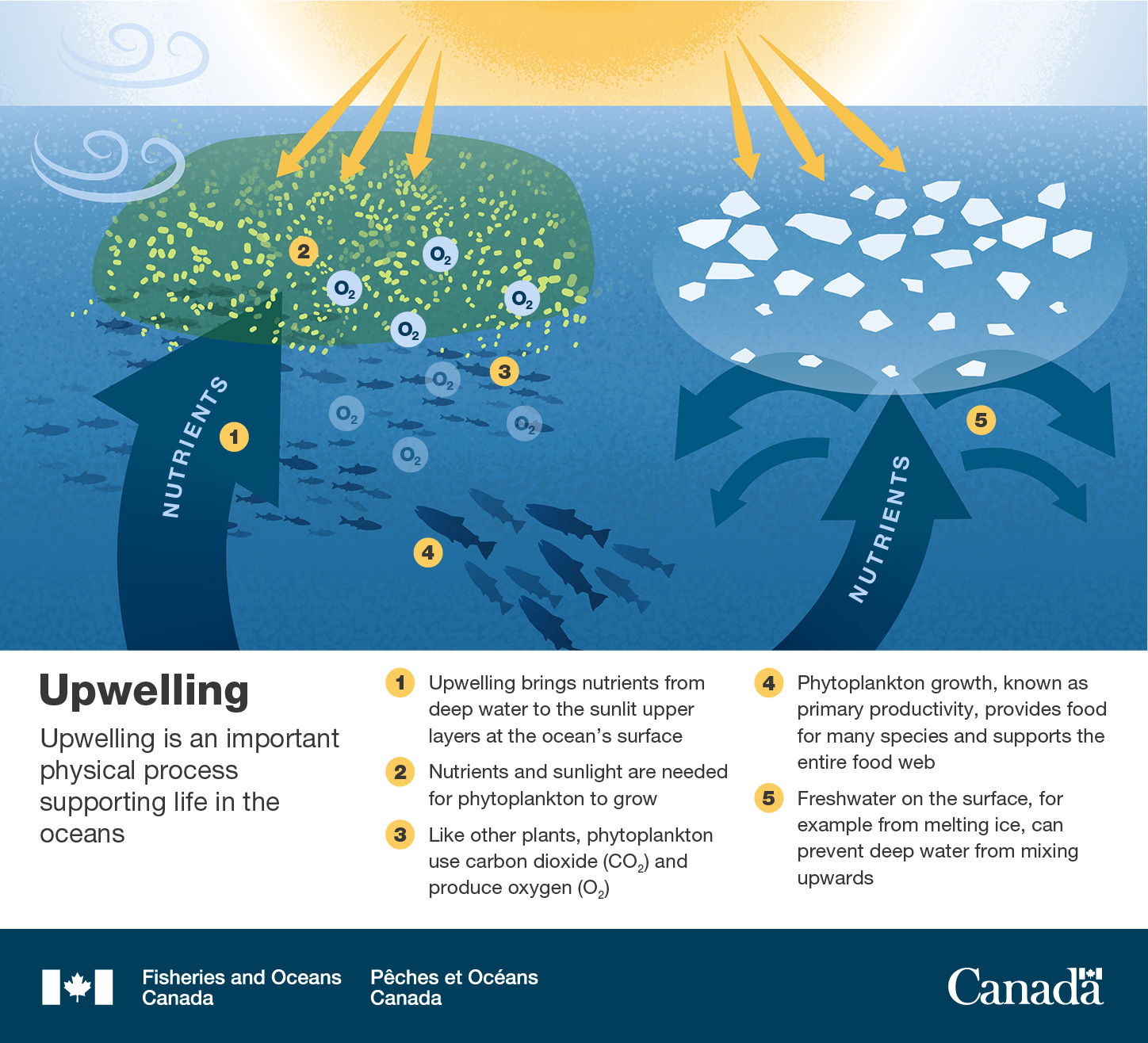
Figure 2: Upwelling, the physical movement of deep, nutrient-rich water to the ocean surface, is an important process supporting the growth of phytoplankton and open ocean food webs.
How we learn: Monitoring ocean climate
Collecting information on ocean climate to detect changes in the environment requires precise measurements of water characteristics over the entire water column and at different times of year. In Canada, oceanographic monitoring programs are conducted at regular intervals to provide long-term records of physical, chemical, and biological conditions of ocean waters.
Ocean monitoring uses anchored and shipboard equipment methods, such as moorings, rosettes, and plankton nets as well as newer technologies such as remote sensing, oceanographic buoys, and gliders. Integrating satellite technology to observe the sea surface with a system of Argo floats to observe the water column has greatly advanced the number and accuracy of oceanographic measurements in Canada over time (See How We Learn, Figure 12: Ocean sampling technologies).
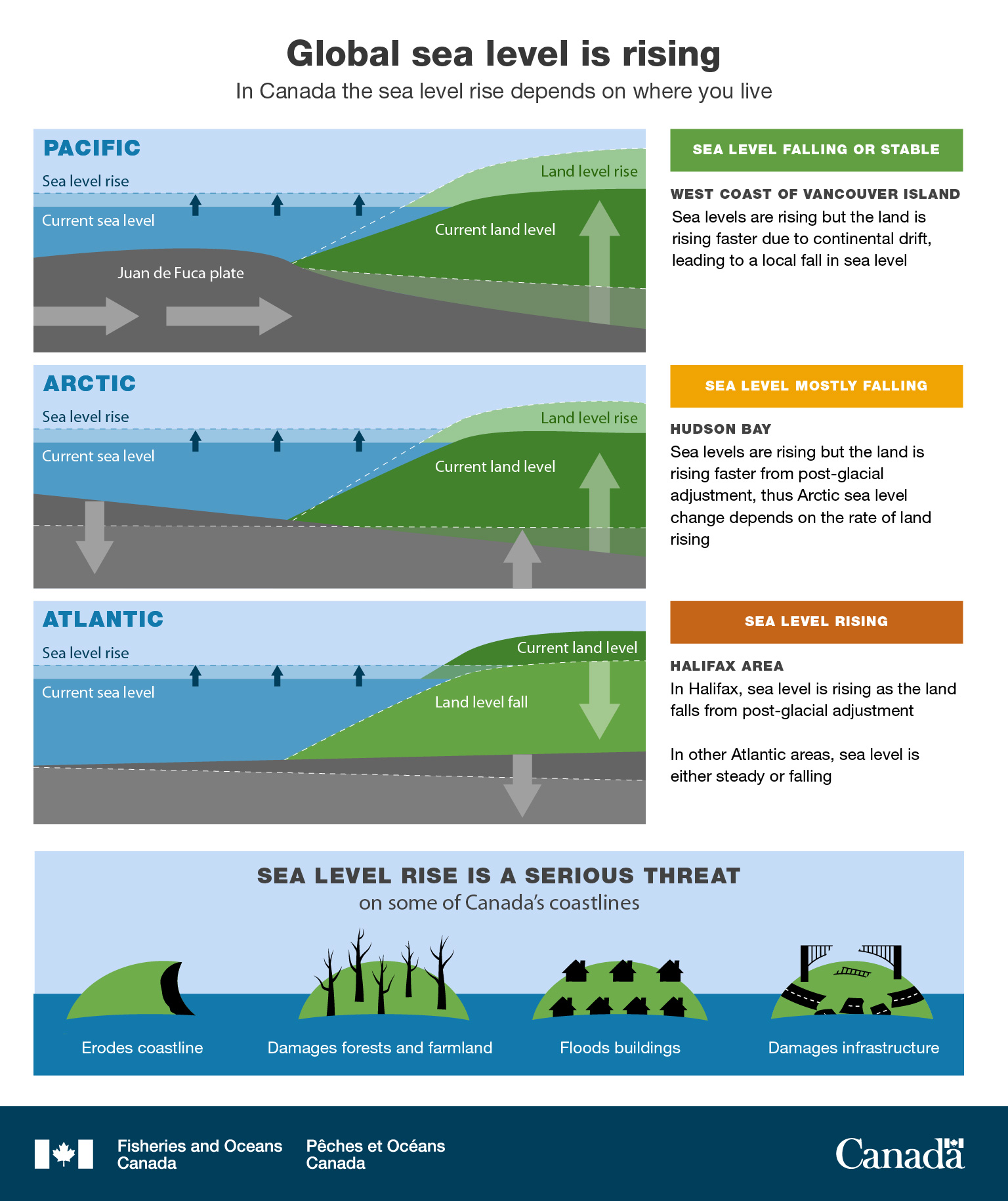
Figure 3: Global sea level is rising. The amount and direction of sea level change around Canada’s coastlines varies because of the influence of local geological processes.
Sea levels are rising globally as a result of increased freshwater input from melting glaciers and ice sheets and the expansion of warming ocean waters. Rising oceans can erode coastlines, damage ocean habitats such as kelp and eelgrass, flood land, and batter buildings and wharfs during storms.
Sea level rise is complex as it varies markedly among Canada’s coastlines, largely as a result of localized geological processes such as continental drift and post-glacial adjustment. For example, on the west coast of Vancouver Island tectonic forces are raising the level of the land faster than global sea level rise, resulting in sea levels falling locally. Sea level is also falling in parts of the Arctic, such as in Hudson Bay, because the land is rising in response to the retreat of the last glacial ice sheet. On the other hand, rising sea levels are occurring faster than average in the Halifax area as the land there is falling.
Ocean chemistry
Ocean chemistry (meaning the amount of oxygen, carbon dioxide, and nutrients dissolved in the oceans) is fundamental to the health of marine ecosystems. However, it is being altered by climate change and human activities. The world’s oceans absorb excess heat and carbon dioxide from the atmosphere, which can have serious biological impacts in the marine environment. The increasing concentrations of carbon dioxide in the atmosphere react with seawater causing oceans to become more acidic, (Figure 4: Biological impacts of acidified waters)and the combination of lower dissolved oxygen in warmer water and less ocean mixing means deep ocean water layers are losing oxygen as well (See Running out of oxygen). Nutrients like nitrogen, phosphorus, and silica are needed to support the marine food web, but excess amounts of some of these nutrients added by human activities can negatively affect water quality. Ultimately, acidification, low oxygen levels, excess nutrients, and warming waters can combine to cause serious problems for marine ecosystems.
State of Canada’s oceans
Ocean acidity has increased in all of Canada’s oceans. Oxygen levels are decreasing in Pacific and Atlantic waters—in some places more than others. The input of excess nutrients is creating polluted conditions along some coastlines and supporting more productive ecosystems in other ocean areas.
In the Pacific
Waters of the North Pacific are naturally low in oxygen compared to other oceans because subsurface waters are prevented from reaching the surface to get more oxygen from the atmosphere by patterns of ocean circulation. Oxygen-poor water in the North Pacific forms an oxygen minimum zone between roughly 500 m and 2000 m. The depth range of this area has expanded over the last 60 years with a 15% reduction in oxygen. These low oxygen conditions pose a threat to some marine animals but may be related to greater numbers of jellyfish observed. Increasing ocean acidification has also been observed in the North Pacific over the last 25 years and is of concern for species in coastal fjords that are sensitive to these changes. Shellfish farmers in the Salish Sea report harmful effects from ocean acidification, especially on the larval stages of shellfish species.
In the Arctic
The strength and area of acidification in the Arctic is increasing as naturally acidic Pacific waters continue to flow into the Arctic Ocean. Due to the acidity of these waters, sea butterflies (pteropods) in the Amundsen Gulf are showing high levels of shell damage. Acidification of ocean waters can occur throughout the Canadian Arctic at different times of year, but ocean acidification trends are not known for most locations. The Pacific water layer in the Arctic is also important for the delivery of nutrients for the food web. Upwelling is a key process bringing nutrient-rich water from the Pacific or other deeper layers to the sunlit surface. Sea ice and temperature changes are affecting where and when nutrients are available for the base of the food web.
In the Atlantic
The acidity of ocean waters along parts of the Atlantic coast is increasing at a rate of 4.5–8.8% per decade. This threat may be particularly important for species with hard shells. For example, laboratory experiments indicate that ocean acidification may worsen the death rates of juvenile stages of American lobster and hinder their growth and development. In the Lower St. Lawrence Estuary, record warm bottom temperatures, additional nutrients from human activities, and lower oxygen have worsened the threat of acidification. Deep-water nitrate, a nutrient necessary to fuel the base of food webs, has been well below the long-term average levels in many parts of the Northwest Atlantic from 2012 to 2016.
Spotlight: Running out of oxygen
Oxygen is a key indicator of ecosystem health. Warming and stratification of ocean waters can lower oxygen to levels that cause major stress to many forms of ocean life (hypoxia). Human activity can also lower ocean oxygen levels.
Excessive inputs of nitrogen and phosphorus from fertilizers in agriculture, sewage disposal, and urban runoff fuel the growth of algae in coastal areas, resulting in large algal blooms. These large algal blooms on the surface of the water prevent sunlight from reaching deeper waters, resulting in the death and decay of plants. Blooms then sink to the seafloor, where they are consumed by microbes that remove oxygen from the water. High water temperatures make the problem worse by speeding up algal growth and the rate that microbes feed on plant matter.
Today, there are worrying signs of worsening hypoxia in some areas of Canada’s Pacific and Atlantic oceans. Waters more than 200 m beneath the surface of the northeast Pacific Ocean are particularly oxygen poor, resulting in an oxygen minimum zone between 500 m and 2000 m below the ocean’s surface. With greater warming, this range has expanded vertically. In the Atlantic, low oxygen conditions in the deep waters of the St. Lawrence Estuary have existed since 1984 and have persisted with the greater influence of lower dissolved oxygen waters from the Gulf Stream and increased nutrient levels due to runoff from land.
Habitats
Human activity and climate change are affecting all ocean habitats — from nearshore to deep offshore waters and everywhere in between.
Canada’s marine habitats include rocky shorelines, seamounts, sea ice, polynyas, and beyond—all supporting a diverse array of ecosystems and species. Marine life depends on healthy habitats—places in the ocean that can provide living creatures with optimal conditions for their growth, survival, and reproduction. From the coasts to offshore, shallow to deep ocean, habitat is provided by a wide variety of environments, ocean conditions, and even marine species themselves. However, human activities and a changing climate are degrading ecosystems for their inhabitants. In some cases, multiple threats have been documented (Figure 5: Canada’s ocean habitats from surface to seafloor).

Figure 5: Canada’s three oceans host a diverse array of habitats that support abundant marine life. These habitats are increasingly experiencing stress due to climate change and human activities.
Nearshore habitats
The coastal seascape of Canada has a diverse array of marine environments—estuaries, rocky shores, salt marshes, kelp forests, mud flats, eelgrass meadows, and land-attached sea ice. Sand and mud habitats just below the coastal high-tide line support worms, molluscs, and small crustaceans—important food for fishes and seabirds. Shellfish harvested in these habitats also support local commercial, recreational, and subsistence fisheries. Eelgrass beds and kelp forests form three-dimensional habitat along coastlines that serve as a protected fish nursery—a safe place for young fishes to feed and grow.
State of Canada’s oceans
Commercial and industrial development along with recreational activities are leading to the degradation of some coastal habitats. Climate change impacts such as sea level rise, increased storm surges, and frozen land melting can cause coastal erosion. Many of Canada’s estuaries are suffering from increased nutrient levels from runoff from land resulting in excessive algae blooms and loss of light and oxygen for plants and animals living on the seafloor. Invasive species in Pacific and Atlantic waters continue to threaten some coastal habitats. Such influences on the coast may also be creating less suitable living conditions for many marine species that depend on these habitats.
In the Pacific
Range expansions of invasive species in the Pacific, aided by a warming climate, are having negative effects on habitats and the species they support. For example, the invasive European green crab, established in areas of the Pacific, continues to be found in new adjacent areas. Large groups of green crabs damage important eelgrass habitat and negatively impact the animal species that live there. Low oxygen in the Saanich Inlet has negatively affected the abundance of commercial shrimp species at their preferred coastal depth.
In the Arctic
Coastal areas across the Canadian Arctic are being altered by the thawing and collapse of frozen cliffs and the decreased protection of shorelines by sea ice. Erosion is threatening homes and historical sites in the western Arctic and is adding sediments and nutrients to the coastal ocean with unknown consequences for marine life. Pristine nearshore habitats are at high risk from increased human activity, such as shipping, which facilitates introductions of invasive species.In the Atlantic
Increased nutrient levels in Atlantic estuaries are leading to loss of habitat quality; in the Gulf of St. Lawrence species living in intertidal flats and eelgrass habitats have decreased. In the nearshore, cold-water-loving kelps face dual threats from warming waters and the presence of an invasive invertebrate, the coffin box bryozoan. In some places, this has destroyed entire kelp forests and allowed opportunistic seaweeds, such as the invasive oyster thief, to establish. Additionally, damage to eelgrass beds by invasive European green crabs has occurred in some areas. Bottom-contact fishing gear is disturbing some seafloor habitats, affecting the marine communities that depend on them.Sea ice habitats
Near the surface of the water column in the Arctic and Atlantic oceans, sea ice supports marine plants and animals. Ice algae bloom in the sea ice, nourishing grazing zooplankton; seals and walruses rest and give birth on the ice; and polar bears travel across sea ice to hunt for fishes and seals. Sea ice is also a fundamental part of the culture and food security of Inuit and affects coastal Atlantic communities. Changes to sea ice can impact all marine animals that live or reproduce on or around it (Figure 6: Sea ice habitat) as well as the open water and seafloor habitats below it. Polynyas are unique and important habitats of open water surrounded by sea ice. These ice-free areas can support an abundance of marine life sustained by high primary productivity—particularly marine mammals and birds.
State of Canada’s oceans
Sea-ice habitat in Canada is undergoing rapid changes. These include sea ice loss, thinning, dominance of seasonal rather than year-round sea ice, reductions in its extent, and changes in timing of yearly sea-ice formation. These changes are linked to climate change and impact the entire ecosystem including marine animals that live or reproduce on or around sea ice. Increasingly dangerous or unreliable ice conditions are also limiting where and when Inuit can travel and hunt on the ice.
In the Arctic
Across the Canadian Arctic, the ice-covered period is shortening—ice melts or clears away earlier and freezes later. In some areas, old ice no longer dominates offshore waters of the Arctic Ocean and the new thinner ice pack is more easily moved around by wind. Around the many islands in the far Canadian north, old ice remains, with some ice as thick as was measured nearly four decades ago in the Arctic Ocean. A unique area with old sea-ice habitat has been established as a Marine Protected Area to protect important ice ecosystems and ice-associated species (See Tuvaijuittuq).
In the Atlantic
The amount of sea ice has been generally lower than average over the past decade. Poor sea-ice conditions have resulted in the loss of breeding areas for grey seals in the Gulf of St. Lawrence. In contrast, the loss of sea-ice extent and northward shift of prey has resulted in more frequent visits by killer whales to the northern areas of the Atlantic and into the Arctic. In coastal areas of Newfoundland, increased eelgrass cover has been linked to less damage from ice due to reduced winter sea-ice conditions.
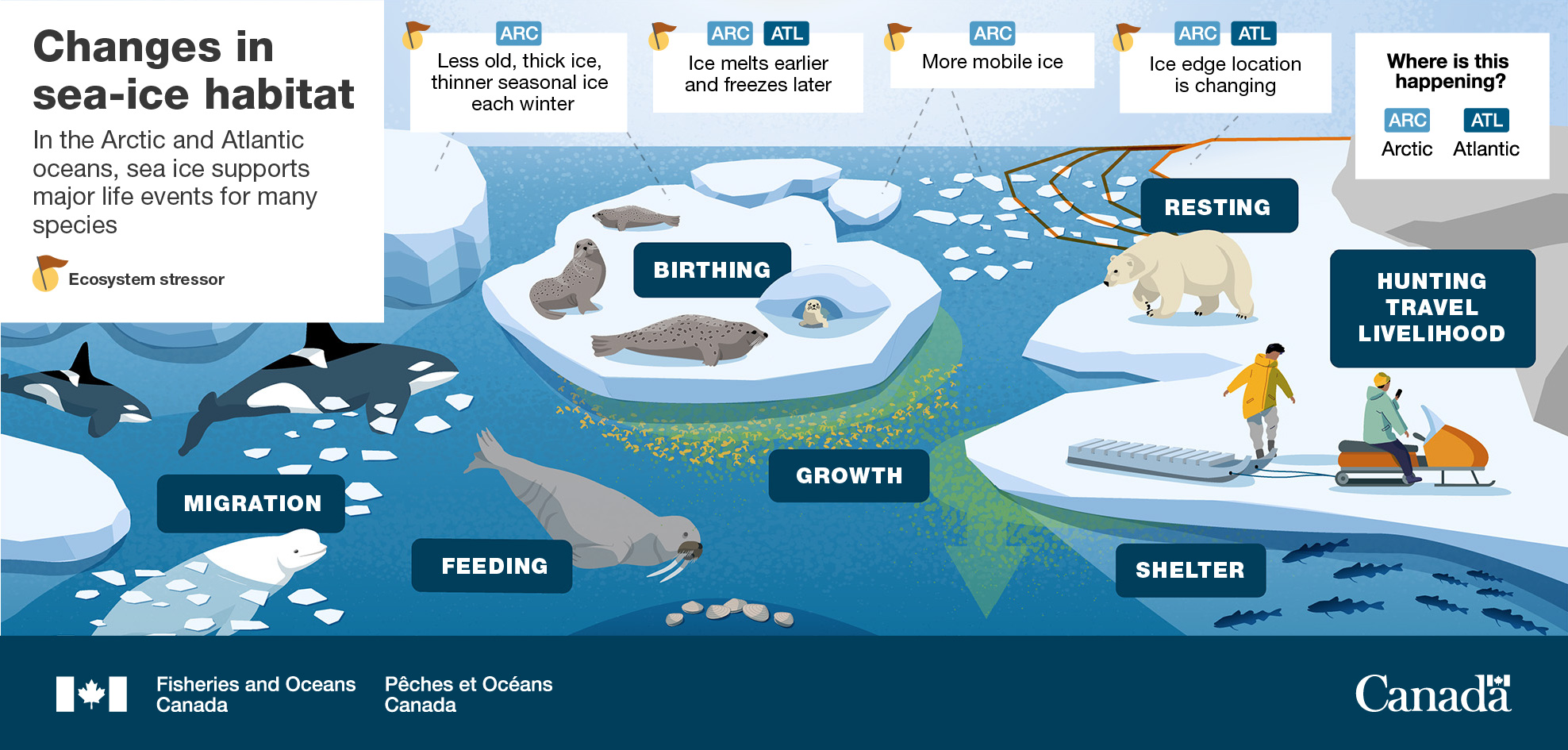
Figure 6: Major life events of species in the Arctic and Atlantic oceans are affected by the many changes in sea ice: presence, timing, and thickness.
How we learn: Exploring habitats
Nearshore habitats are often explored from the shoreline or from small boats using small scale equipment such as nets and sensors or divers to acquire information. Aerial drones are also being used to provide wide overhead images or video to measure habitats such as eelgrass and kelp. When it comes to exploring offshore and deep sea habitats, large ships that can support collaborative research and specialized equipment are needed. Remotely operated vehicles (ROVs) on research vessels allow for the exploration of habitats rarely seen before. Remote sensing technologies such as multibeam sonar, aircraft-borne LiDAR (light detection and ranging), and earth observation satellites can be used to map and study habitats such as surface waters, the seafloor, and sea ice (See How We Learn, Figure 12: Ocean sampling technologies).
Spotlight: Tuvaijuittuq
Tuvaijuittuq, meaning “the place where the ice never melts” in Inuktitut, is a special area of sea-ice habitat located off the northwest coast of Ellesmere Island in Nunavut. This ecologically and culturally significant area is a unique region of persistent old sea ice—sea ice that has survived at least a second summer without completely melting. The amount of thick, old ice habitat has been quickly declining across the Arctic and the remaining old ice is much thinner than it used to be. Sea ice older than four years made up 1% of the Arctic Ocean ice pack in spring 2019 compared to 33% in 1985. The remaining old ice is largely confined to Tuvaijuittuq where it is also predicted to persist in future decades.
Consequently, Tuvaijuittuq can be an important habitat for ice-dependent species including seals, walruses, and polar bears. Major questions remain about the integrity of Arctic ecosystems without the year-round presence of sea-ice habitat (See Figure 6: Changes in sea-ice habitat). In 2019, Canada designated Tuvaijuittuq as a Marine Protected Area to protect the oldest sea ice of the Arctic Ocean as well as its associated habitats,ecosystems, and species.
Offshore habitats
Offshore habitats include pelagic and water column environments of the open ocean as well as deep sea habitats. Despite their deep and often harsh conditions, offshore and deep sea marine environments host a surprising diversity of habitats that support unusual organisms. Seamounts can rise over 1,000 m from the seafloor creating biodiversity hotspots. Hydrothermal vents, cold seeps, and mud volcanoes are places where hot, chemical-rich fluids escape from the seafloor, sometimes sustaining lush communities in very harsh environments. Cold water corals and sponges shelter small fishes and invertebrates from predators, serving as feeding areas, resting sites, and protected areas for eggs (See Life at the extremes).
State of Canada’s oceans
The extent and health of offshore habitats provided by corals and sponges, seamounts, and hydrothermal vents in Canada has declined in some areas due to physical disturbance (bottom-contact fishing and resource extraction), pollution, and variation in ocean climate (warming waters). Living coral gardens and glass sponge reefs are especially vulnerable habitats as they are slow growing; even after bottom-contact fishing is prohibited, it takes a long time for these species to recover. Lost or discarded fishing gear may continue to impact all of these habitats.
In the Pacific
The number of identified Canadian seamounts in the Pacific has tripled in the last two years; however, low-oxygen conditions are affecting animals living on them. Underwater surveys have shown that most glass sponge reefs (some located in the nearshore environment) have been negatively affected by human activities and are in poor overall condition and have been in poor overall condition for the last five years.. Living coral gardens and glass sponge reefs are especially vulnerable habitats as they are slow growing, and recovery may be hindered by ongoing physical and environmental threats.
In the Arctic
Deep sea corals and sponges and mud volcanoes are unique offshore habitats in Arctic waters. There are also ocean canyons and troughs, where adult Arctic cod, key prey fish in the Arctic, prefer to live; beluga can dive to depths over 1,000 m to access their preferred prey. There is a vast area of offshore habitats in Canada’s Arctic that has never been studied and the biodiversity is still unexplored.
In the Atlantic
Forty species of coral are known from Atlantic Canadian waters, although in many areas, sponges are the dominant organism in terms of abundance and biomass. Corals and sponges have not been fully documented in Atlantic waters, and many new species continue to be discovered. The only known coral reef complex in Atlantic Canada is found at 300 m depth on the Scotian Shelf and measures over 1 km in length. In the Gulf of St. Lawrence Channel, dense groups of sea pens are found, forming habitat for other species. Deep sea corals and sponges are highly vulnerable to human activities like fishing and resource extraction. Corals may also be vulnerable to the effects of climate change as some species can only survive at certain temperatures.
Spotlight: Life at extremes
Among the unique offshore habitats in Canada’s oceans are places where chemical and physical conditions are considered extreme compared to other deep sea habitats. Hydrothermal vents and cold seeps in the Pacific Ocean and mud volcanoes in the Arctic Ocean are places where gases spew up from the seafloor. The resulting chemical habitat provides energy to microbes—the base of the food web—which survive by using chemicals (chemosynthesis) rather than sunlight (photosynthesis).
In the deep Pacific Ocean, tectonic plate movement has given rise to hundreds of vents on the seafloor. From these vents, plumes of superheated, mineral-enriched water can rise 200-300 m up into the water column. Some vents form large cylindrical “chimneys” composed of solidified minerals from the plumes. Hydrothermal vents host one of the world’s highest diversities of microbes. The vents on the Juan de Fuca Ridge host around 60 distinct animal species, 12 of which do not exist anywhere else in the world. Microbes support life around the vents either as free-living organisms or within the bodies of other animals, such as large vent tubeworms.
In the Canadian Beaufort Sea, active mud volcanoes spew warm mud and methane into the Arctic ocean waters. In 2013, tubeworms that use chemosynthesis to survive were discovered living on these mud volcanoes. They form the first and only –known chemosynthetic community in Canadian Arctic waters.
In the deep waters 200 km off the east coast of Nova Scotia lies the Gully, a deep ocean canyon that extends two kilometres under the ocean surface. It is the largest underwater canyon in the western North Atlantic and one of Canada’s Marine Protected Areas. Here, cold-water corals—some more than 1,000 years old—occupy the canyon walls and slopes. This spectacular habitat is a diversity hotspot for all levels of ocean life, from tiny brittle stars to an endangered population of northern bottlenose whales.
Species
The number, range, and growth of plants and animals in the ocean are shifting in ways that are difficult to predict.
Changes in the ocean environment are altering the abundance (numbers) and distribution (range) of phytoplankton, zooplankton, plants, invertebrates, fishes (Figure 7: Fish on the move), marine mammals, seabirds, and sea turtles. The response of plants and animals to seasonal and year-to-year climate variability depends on their ability to adapt. In addition, human activities such as fishing, shipping, and resource extraction can directly affect species abundance and distribution, which can leave some species more vulnerable to environmental change. Some groups of species, like Canada’s many species of shrimp, tell a complex story of warming waters, overfishing, and increased predation (Figure 8: What’s the catch with shrimp). For many species, trends in their abundance over time or in their distribution are still not known.
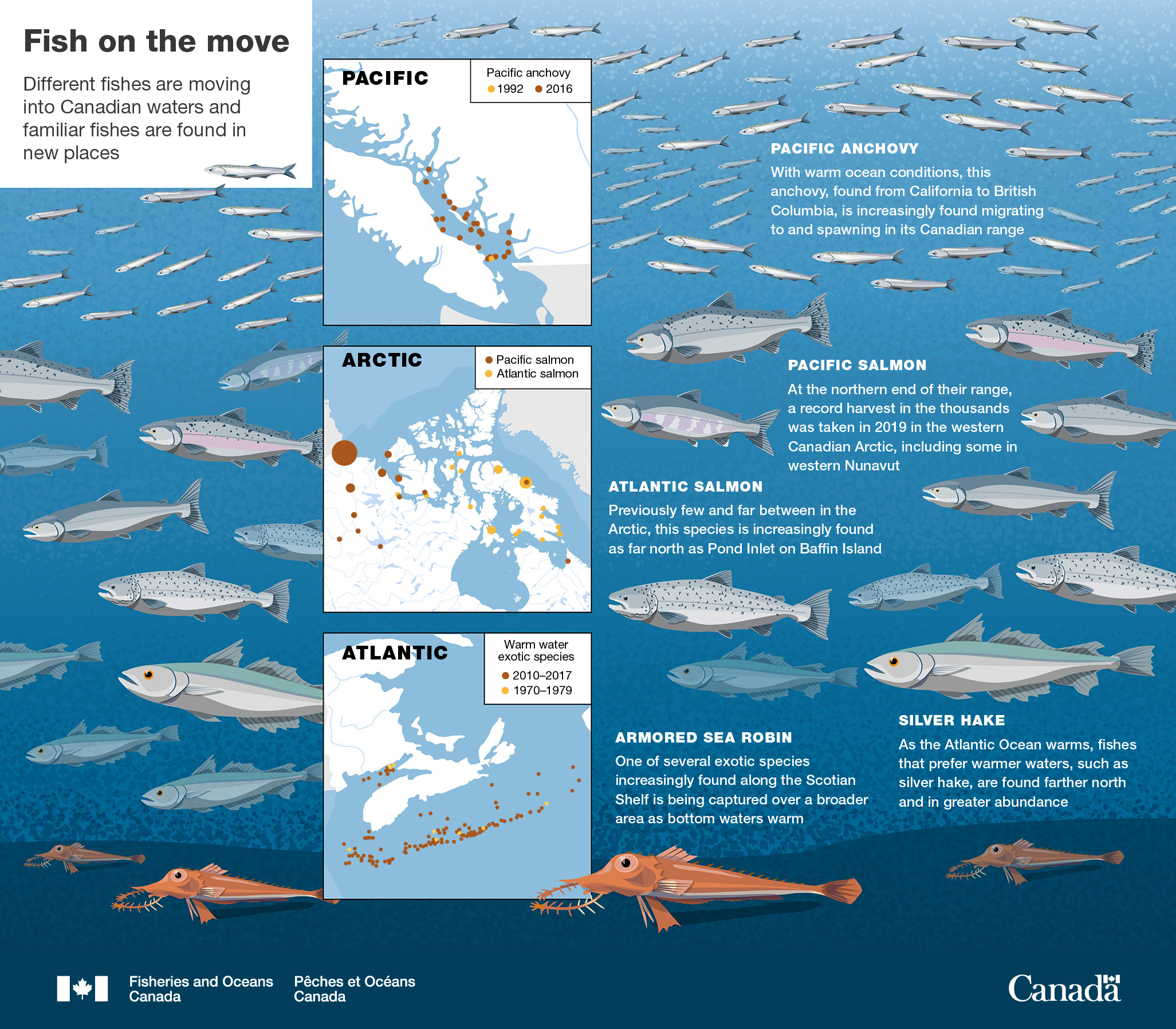
Figure 7: New information shows how fishes in Canada’s oceans are arriving and moving to different areas. The distribution of many Canadian fish species is shifting in response to changing environmental conditions in all three oceans.
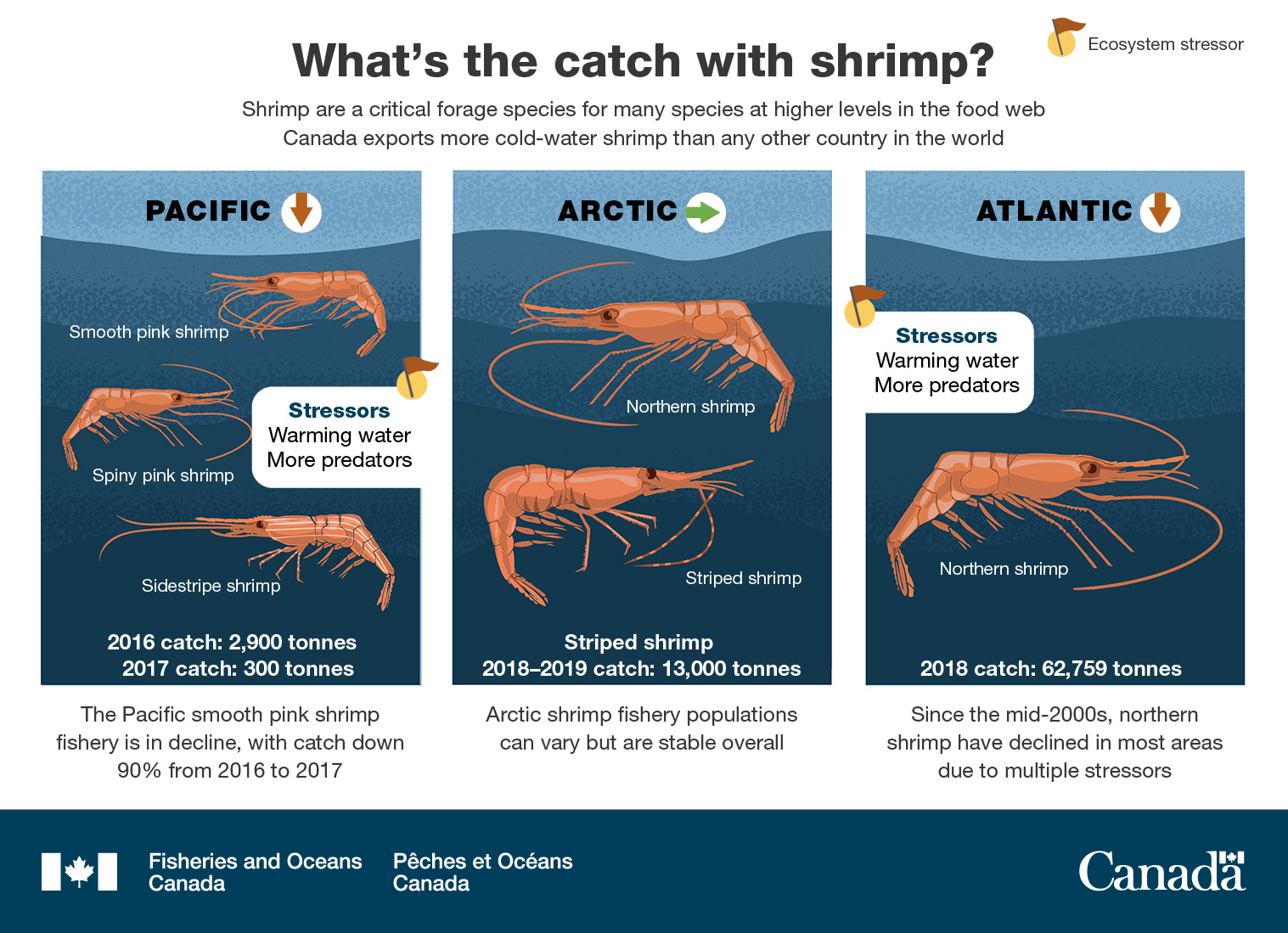
Figure 8: Shrimp are important harvest species for the fishing industry. Warming waters, overfishing, and increased predation are major factors affecting abundance of shrimp in the Pacific and Atlantic Oceans.
How we learn: Studying species
Monitoring the health of species is an important part of ocean science. This means understanding where a species lives, where and when it reproduces, its growth, health, and death rates, its numbers, and its movement pattern. Information on invertebrates, fishes, marine mammals, and seabirds is gathered through a number of separate research approaches. Common approaches to studying ecosystems are plankton tows, multispecies fishing trawls, and hydro-acoustic and video surveys. These surveys are carried out from research vessels and used to monitor the distribution and abundance of plankton, invertebrates, and fishes. Marine mammals and birds are observed from the land, sky, and sea and even tracked by satellite tags. Listening for underwater sounds is an important way of monitoring whale populations. Invasive species and their spread are studied through deployment of collector plates or trapping depending on the species. Yearly monitoring of species provides long-term data needed to conserve and protect marine life (See How We Learn, Figure 12: Ocean sampling technologies).
Species trends
Marine life can respond positively or negatively to changing ecosystem conditions, depending on the context. Population numbers may increase or stabilize after a species moves to take advantage of more suitable habitat. A species may also benefit from greater food availability fueling their population growth. Other positive changes can result from conservation efforts, such as the reduction of commercial harvest or protection of habitat. On the other hand, marine species can be negatively affected by continued human activities or by climate changes to the ecosystem. If a habitat becomes more stressful or offers less food, the health, number, or range of a species declines. Understanding the distribution and abundance of marine species in ever-changing ecosystems can be challenging.
State of Canada’s oceans
Climate change and human activities are the dominant pressures acting on Canada’s marine ecosystems.
Some populations of invertebrates, fishes, marine mammals, and seabirds are increasing or stable over time and others are decreasing. Animals that are normally occasional visitors in Canada’s oceans are being increasingly observed and previously unknown species are now appearing. Management efforts have allowed the recovery of some populations, but other populations continue to decline. Climate change impacts are creating new and complex challenges for individuals and populations. Population trends of many marine species in Canada are unknown, especially in the Arctic where information on a number of species is sparse.
Increasing and stable trends
In the Pacific
Recent unprecedented marine heatwaves in the Pacific have contributed to the altered distribution and abundance of some marine species, such as pyrosomes. Normally found only as far north as California, these tubular free-floating invertebrates are low-oxygen tolerant and were abundant along the beaches of British Columbia in 2017. Warmer ocean temperatures have also played a role in the increased abundance of northern anchovy migrating to and spawning in Canada’s Pacific waters as well as sightings of triggerfish, swordfish, and bottlenose dolphins in recent years. Other species have shown variable or stable trends. The trends of Pacific herring, an important forage fish, vary by area, and many salmon population abundances are declining in British Columbia, with some exceptions (See A salmon story). The abundance of harbour seals in the Strait of Georgia increased following their protection in the early 1970s and then stabilized in the mid-1990s. Steller sea lion populations have also rebounded and continue to increase in British Columbia. Following depletion by commercial whaling, the number of humpback whales continues to increase and their distribution has been expanding over the last ten years. Populations of northern resident killer whales and Bigg’s (transient) killer whales have also been increasing.
In the Arctic
Pacific salmon have recently increased in number in the northern extent of their range and are now being caught in nets intended for Arctic char(See A salmon story). Bowhead whales in the Arctic are known to be increasing in numbers, recovering from historical whaling. Shrinking ice has allowed both beluga and killer whales to spend more time in Hudson Bay (See Whale tales). Commercially harvested species including shrimp and Greenland halibut are currently stable as are several harvested stocks of Arctic char and Dolly Varden.
In the Atlantic
Exotic warm water fishes, such as American John Dory, armored sea robin, spotted tinselfish, and deep-bodied boarfish are being found more often on the Scotian Shelf. American lobster, which prefer warmer temperatures, have increased in abundance over the last decade in most areas and are expanding their distribution to deeper waters on the Scotian Shelf and to the north of the Gulf of St. Lawrence. Other warm water species, such as silver hake, have shifted their distributions and increased in abundance in some areas in response to warming temperatures. The closure of the large-scale Atlantic cod fishery in a;1992 has decreased the chances of seabird entanglement in gillnets, allowing some species such as common murres and Atlantic puffins to experience population growth. Some fish populations previously impacted by overfishing, such as Atlantic cod and American plaice, have had modest increases in some areas but are nowhere near their historic abundances. Other fish, like Atlantic halibut and Atlantic redfish and mammals, like humpback whales and grey, harp, and ringed seals have also been increasing in numbers. Sightings suggest leatherback turtle populations are likely stable, but current population size and trends remain unclear.
Spotlight: A salmon story
Atlantic and Pacific salmon spend their early lives in freshwater streams, rivers, and lakes then one or more years in the ocean before returning to freshwater to spawn as adults. Changes in these environments and other factors, including fishing, hatcheries, disease, pollutants, and new invasive species, have collectively impacted salmon populations.
Warming oceans and marine heatwaves are affecting environmental and biological processes in the ocean. These changes are contributing to salmon population declines in both the Atlantic and Pacific oceans. Warmer ocean years are becoming increasingly common and this has resulted in shifts towards less nutritious species of zooplankton—an important food source for salmon. These changes near the base of the salmon food web may be a big reason for the trends observed for many salmon populations.
Canada’s iconic salmon varies across its three oceans:
- In the Pacific, Chinook salmon have declined throughout their range. Sockeye and coho salmon have declined, particularly in southern latitudes, while chum and pink salmon have generally been stable.
- Most Canadian populations of Atlantic salmon (a single species) are declining and some are experiencing critical declines, such as those in the Bay of Fundy.
- In the Arctic Ocean, local communities are reporting that salmon are now being caught in greater numbers. A record number of Pacific salmon were caught in the western Arctic in 2019, with thousands collected by fishers in the Beaufort Sea and the Mackenzie River and some even found further east in Nunavut (Figure 7).
Spotlight: Whale tales
Studying Canada’s whale populations provides insight into their behaviour and movement.
In the Atlantic Ocean, North Atlantic right whales are moving north into the Gulf of St. Lawrence. Their favourite prey, a nutritious species of zooplankton, has increased in abundance there. But the Gulf is a busy fishing and shipping area. Right whales are now increasingly at risk of being killed or injured after being entangled in fishing gear or being struck by vessels.
In eastern Arctic waters, shrinking sea ice has allowed killer whales to explore areas they may never have visited before. In recent decades, sightings of killer whales in Hudson Bay have increased drastically. Because these killer whales prey on other whales, narwhal and bowhead are changing their behaviour and location in response to these aggressive predators.
Some whale populations are facing challenging environmental and food conditions. This has led to a critical situation for the endangered southern resident killer whale population off the Pacific coast. This population of killer whales has dwindled to an estimated 73 individuals, in part because Chinook salmon (which provide 90% of their summer food) are declining in several areas.
Decreasing trends
In the Pacific
Multiple stressors, such as warming ocean temperatures, decreasing dissolved oxygen, changes to the food web, and human activities have negatively affected some species in the Pacific. Smooth pink shrimp are declining off the coast of Vancouver Island due to warm water and predation, and the abundance of commercial smooth pink shrimp species in Saanich Inlet has been negatively affected by low oxygen. Eulachon populations have also experienced long-term declines in many rivers from California to Alaska. Pacific sardine population is low in British Columbia and has not yet returned to previous levels. Chinook salmon numbers are declining and populations of sockeye and coho salmon are doing poorly in southern latitudes (See: A salmon story). The numbers of southern resident killer whales are low and expected to keep declining under current conditions (See Whale tales).
In the Arctic
Long-term trends of marine mammals, fishes, and their supporting prey are generally not known for many species in the Canadian Arctic. Abundances can sharply decline in a single year (for example Arctic cod in 2014) and appear recovered the next. However, extreme warming events have been documented to impact populations such as in 2010 when a low ice year combined with warm temperatures resulted in lower ringed seal pup survival in Hudson Bay.
In the Atlantic
Overharvesting of many species has reduced their populations and many have not recovered from historically low levels. Abundances of Atlantic herring (Gulf of St. Lawrence and western Scotian Shelf) and Atlantic mackerel (entire North Atlantic) have declined. Species such as blue whales, North Atlantic right whales, St. Lawrence beluga, capelin (Newfoundland and Labrador Shelves), and northern shrimp do not appear to be recovering. Snow crab, a species with a preference for colder waters, has been impacted by warming of deeper waters, contributing to recent declines in some areas. Numbers of surface-feeding seabirds like herring gulls and black-legged kittiwakes have declined, in part due to the reduced availability of high-quality prey fish.
Food webs
Food sources and when they are available in ecosystems are changing, with consequences for marine life.
Marine food webs represent linkages among living organisms in the ocean. Most food webs start with phytoplankton at the bottom (microscopic single-celled plants and bacteria), which are eaten by zooplankton (small animals that drift or swim in water), which in turn are eaten by fishes and invertebrates and ultimately marine mammals. Because of these linkages, changes to one part of the food web have implications on the status and health of the rest of the food web. Since, the livelihoods and well-being of many people in Canada’s coastal communities are dependent upon marine food webs, changes to marine food webs affect the people that depend on them too. When changes to habitat or environmental conditions affect lower parts of the food web, impacts flow upwards: bottom-up control. When changes occur at the top of the food web, such as predator abundance or behaviour, impacts flow downwards: top-down control.
From the bottom up
Phytoplankton need sunlight and nutrients to live and grow, and when conditions are right, they can grow rapidly—blooming in the spring, summer, and fall. Changes in the peak timing of these blooms can impact the food web from the bottom up (Figure 9: Timing is critical). Zooplankton, a diverse group of copepods, krill, jellyfish, and larval stages of fishes and shellfish are food for forage fish, some larger-sized fishes, turtles, and some whales and seabirds. Changes in zooplankton communities have impacts on their predators (See Shifting links in food webs, Figure 10: Zooplankton). Forage fishes, such as Arctic cod, capelin, and herring are, in turn, food for other larger-sized fishes as well as seabirds and marine mammals (See Forage fish at the centre of food webs).
State of Canada’s oceans
The type and timing of phytoplankton blooms affect zooplankton species abundance, composition, timing, and distribution. In turn, a match or mismatch in timing between phytoplankton blooms and zooplankton impacts the amount of food available to their predators, such as forage fishes, seabirds, and whales.
In the Pacific
In the Pacific, nutrient-rich deep water upwells and mixes into the upper ocean layer, fueling phytoplankton growth and the rest of the food web. In warmer years, zooplankton communities shift towards a greater abundance of a less nutritious southern copepod species and fewer of the energy-rich northern copepods. The southern copepods are considered to be an energy-poor food for other animals in the food web, such as juvenile salmon and seabirds due to their smaller size and lower energy content. Triangle Island, British Columbia, has the world’s largest breeding colony of Cassin’s auklets; these seabirds grow more quickly when there are more energy-rich northern copepods present in their diets. The timing or match/mismatch between when food is available and when herring larvae (a forage fish species) first start to feed is important to their survival.
In the Arctic
Thinning sea ice as well as earlier yearly ice clearance (or melt) is altering the timing and type of phytoplankton blooms. In some areas there is evidence that marine ecosystems are changing from a sea-ice-based to open-water supported food web. At these locations, more energy for the food web now originates from phytoplankton rather than the algae that grows in sea ice in the spring. The response of zooplankton and fishes to changes in the timing and characteristics of phytoplankton blooms are not well understood for coastal and offshore areas.
In the Atlantic
Mixing of ocean waters creates biologically productive marine ecosystems that drive the growth and abundance of capelin and their predators—Atlantic cod and harp seals. When less prey, or food, is available during mismatched phytoplankton blooms, forage fish abundance can decrease. In turn, declines in capelin are delaying the recovery of cod that feed on them, and declines in herring are affecting the health of seabirds, such as terns and puffins. Populations of seabirds such as northern gannets, herring gulls, and black-legged kittiwakes have leveled off or declined in recent years, due in part to a reduction in the abundance and shifts in the distribution of high-quality prey fish. Large densities of clams and worms that live within the sediments of intertidal flats of the Bay of Fundy support the migration of millions of shorebirds each year.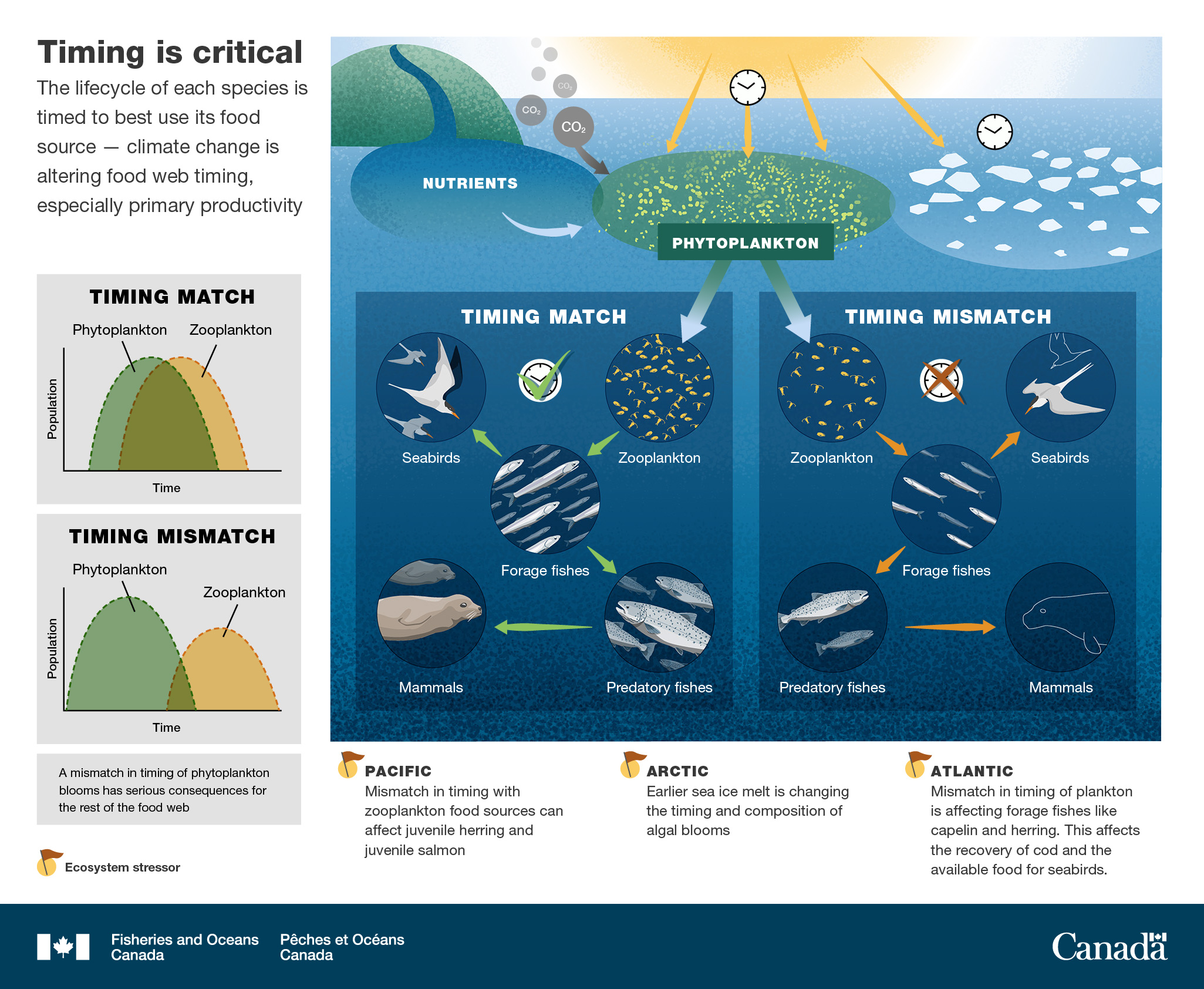
Figure 9: Changing oceanographic conditions are altering the timing of spring phytoplankton blooms—with cascading consequences to food availability for other species.
Sidebar: Shifting links in food webs
Zooplankton are the first step in transferring energy from the base of the food web (phytoplankton) to their predators. These organisms graze in the water column, some drifting with the currents and some making migrations between the surface to deeper waters every day. They are one of the ocean’s most abundant food sources.
An energy-rich source of fats and protein, zooplankton are food for forage fish, young of other fish, and some whales. Zooplankton groups include crustaceans such as krill and copepods, larval stages of fish and shellfish, and larger gelatinous species such as jellyfish.
In the Atlantic and Pacific oceans, there are significant shifts in phytoplankton and zooplankton abundance and species compositions, thought to result from warming ocean temperatures (See Figure 10). As ocean waters warm and cold water copepods are replaced by warm water species, there is less energy available to fishes.
Sidebar: Forage fishes at the centre of the food web
Small fishes often play a central role in pelagic food webs. They feed on plankton at the base of the food web and are in turn prey for larger fishes, seabirds, and marine mammals. These forage fishes, such as Arctic cod, capelin, and herring, are thus a critical link in transferring energy within the ecosystem.
Forage fishes' diets range from phytoplankton, including diatoms, to zooplankton, including copepods and krill, depending on the species and the age of the fish.
The numbers of forage fishes can vary considerably from one area to another and from one year to another. A significant change in their abundance can have serious impacts on food webs and the successful reproduction of their predators.
How we learn: Unraveling food webs
To understand how complex marine food webs work, researchers bring together information from the wide variety of marine science disciplines. This means combining data from physical and chemical oceanography with knowledge of habitats and the biology of plants and animals, including humans. Knowing who eats what and when is a fundamental part of understanding food webs. One method for unraveling diet information includes collecting and analyzing stomach contents to look for linkages between predator and prey species. (See How We Learn)
From the top down
More or less favourable environmental conditions or more or less pressure from human activities, such as fishing and harvesting, can impact predators in marine food webs. In turn, predators can have significant impacts on lower parts of the food web, particularly on their immediate prey species. This is especially evident in close predator–prey relationships, where predators only feed on a single type of prey. Changes to predator abundance, distribution, or prey choice can flow down towards prey species, impacting their abundance and range. These are important relationships that maintain balance within marine food webs.
State of Canada’s oceans
The relationships between predators and prey in Canada’s oceans are shifting. Some predator–prey relationships have become less predictable because they are affected by fishing or hunting, loss of sea ice, or changing temperatures. Human impacts continue to contribute to changes to food webs in both positive and negative ways.
In the Pacific
Smooth pink shrimp are declining off the west coast of Vancouver Island due to a combination of warming temperatures (a bottom-up process) as well as increased predation (a top-down process). Several marine mammal populations in Canadian Pacific waters have shown strong recovery trends and their large numbers have the potential to impact food webs. For example, the increase in the number of Bigg’s killer whale sightings in coastal British Columbia is likely slowing the population growth of their prey, harbour seals, which had recovered after the end of commercial exploitation in the 1970s. Sea otter populations, reintroduced to British Columbia after being hunted to near extinction, increased as a result of their protected status and abundant invertebrate prey. In several areas, sea otter population growth has slowed as they have exerted a strong top-down pressure on their invertebrate prey, which, in turn, has had positive impacts on kelp.
In the Arctic
In Arctic waters, predators are adapting to eat different foods. Some fishes and marine mammals have changed their diet to eat more similar prey to one another as sea ice conditions change. It is unknown if groups of predators with similar diets will weaken the ecosystem’s ability to deal with future environmental change. In a single year, predator diets may shift entirely. For example, belugas harvested near Ulukhaktok (Beaufort Sea) in 2014 were found to have mostly fish other than the expected Arctic cod in their stomachs as well as squid beaks.
In the Atlantic
In the northwest Atlantic the number of grey seals has rebounded in the last few decades, slowing the recovery of their prey, Atlantic cod, in the southern Gulf of St. Lawrence and elsewhere. In contrast, Atlantic cod stocks off the northeast coast of Newfoundland increased in abundance over this same period despite a large harp seal population. In the northern Gulf of St. Lawrence, increased predation from bottom-dwelling fish species like redfish may have contributed to declining populations of benthic invertebrates. In some offshore areas of the Atlantic, leatherback sea turtles may contribute to ecosystem balance by consuming jellyfish, a major predator of zooplankton and larval fish.
How we learn
Combining multiple methods and knowledge systems helps broaden our understanding of Canada’s oceans.
Humans have long been expanding their knowledge and understanding of the oceans. Indigenous knowledge has accumulated and evolved over centuries to inform the safe navigation of Canadian waters, provide food security, and sustain relationships and cultural practices. Today, a wide range of complementary and collaborative approaches are being used to further study and more holistically understand Canada’s oceans.
Monitoring and research
Long-term monitoring programs combined with focused research are the foundation for understanding Canada’s oceans. These programs allow scientists to detect changes happening in ocean environments and help them learn about the status and trends of species and habitats. The longer these programs run, the better the information becomes. Monitoring programs that extend over several decades are used to identify observed changes as either a long-term trend, part of a cycle, or a one-off event. For example DFO has monitored Pacific Ocean oxygen levels since 1960 and temperature in coastal areas of Newfoundland and Labrador since 1967. Field and laboratory research studies are also undertaken across Canada’s oceans to address specific questions such as those related to ocean climate, habitats, species, and food webs. Together, ocean monitoring and research activities continue to improve the understanding Canada’s marine ecosystems as well as their conservation and management.
Ocean science through monitoring and research not only provides new insights into Canada’s oceans and their complex marine life, but also helps scientists ask the right questions for future research (See Building Knowledge, Figure 11).
Evolving ocean technologies
Much of the monitoring and research in Canada’s oceans is done using standard tools such as oceanographic sensors and fishing trawls, but innovative, evolving ocean technologies are increasingly providing new kinds of observations that improve large-scale and long-term monitoring (Figure 12: Ocean sampling technologies). Different tools are used together to study and sample the different aspects of Canada’s oceans to help us gain a greater understanding of these marine ecosystems.
Remote sensing technologies collect data from a distance by detecting energy reflecting from the surface of the planet. These tools include satellites, sonar, and aircraft-borne light detection and ranging (LiDAR). These technologies are making hydrographic surveys, multispecies surveys, and habitat maps more complete and more accurate.
Passive and active sampling technologies are providing researchers with high resolution oceanographic data with lower effort. Specialized sensors can be installed on fixed moorings, floating circulation trackers, or remote controlled gliders to transmit information on water characteristics, animal movements, and ocean noise.
High definition imaging, taken from above or below the ocean’s surface, is providing non-invasive and detailed ways to study marine biodiversity—especially in unique habitats—and live animal behaviour. Below the surface, drop cameras and remotely operated vehicles (ROVs) capture immersive underwater views of the seafloor; above the surface, aerial drones take wide-angle surveys of coastal and open ocean areas that are otherwise difficult to reach.
Electronic tagging of marine life paired with underwater acoustic microphones and satellite tracking greatly increases our understanding of species movements and habitat use. This technology is especially helpful for tracking migratory fishes, sharks, seals, whales, turtles, and seabirds over long ranges and time periods.
Innovative analyses of seawater and animal tissue samples are being undertaken in Canadian ocean science labs. New equipment and digital tools are being combined in sample and data processing. Water samples can now be analyzed for environmental DNA to reveal which species were recently in a given area with greater detail than physical sampling alone.
Collaborative science
Ocean science increasingly means working together. Many complex issues in ocean science are better understood through stronger cooperation at the local, regional, national, and international levels as well as across areas of research. Cooperating in this way helps align research plans and funding and opens up opportunities to continue to support technologies and furthering Indigenous self-determination in research.
Collaboration in ocean science takes on many forms to suit its varied participants, which may include governments, Indigenous groups, academia, non-governmental organizations, industry, and community groups.
Research partnerships between government and non-government organizations or other groups with a shared interest in ocean science are being established more often. At-sea-science expeditions aboard vessels that can support a variety of areas of research and complex equipment offer a greater depth of understanding to the research area. By expanding the number of parties collecting data, we can expand our knowledge of our coasts.
Weaving Indigenous knowledge with scientific information is often done through joint development of research objectives and plans or collaborative work on specific projects. Scientists work alongside Indigenous peoples to address issues related to Canada’s coastlines and marine resources, especially those contributing to food security and maintaining cultural identity. Community-based and community-led programs also provide important information about fishes and marine mammals and their environment (see Learning together).
Community science is a growing source of monitoring and research data in Canada. Many new digital technologies facilitate communities who want to engage in ocean science to collect useful scientific information. Information gathered from the public can range from casual observations to coordinated data collection; both can help scientists understand complex issues, including changes in species movement patterns and the health of populations.
The Future of ocean science in Canada
Canada is exploring more parts of the ocean than ever before as new technologies and remote data collection are being tested and used for research. Our understanding of the oceans continuously grows as monitoring and research is carried out more collaboratively and information is updated and shared sooner and more broadly. Computer-based analysis, including modeling and detailed mapping, has become the backbone of ocean science, which is leading to a better understanding of ocean ecosystems and improving our ability to report the state of the oceans to Canadians and decision makers.
The ongoing advancement of marine science technologies alongside multiple knowledge systems through collaborative partnerships shows that innovative and inclusive approaches to monitoring and research in the marine environment will continue to evolve.
Sidebar: Building knowledge
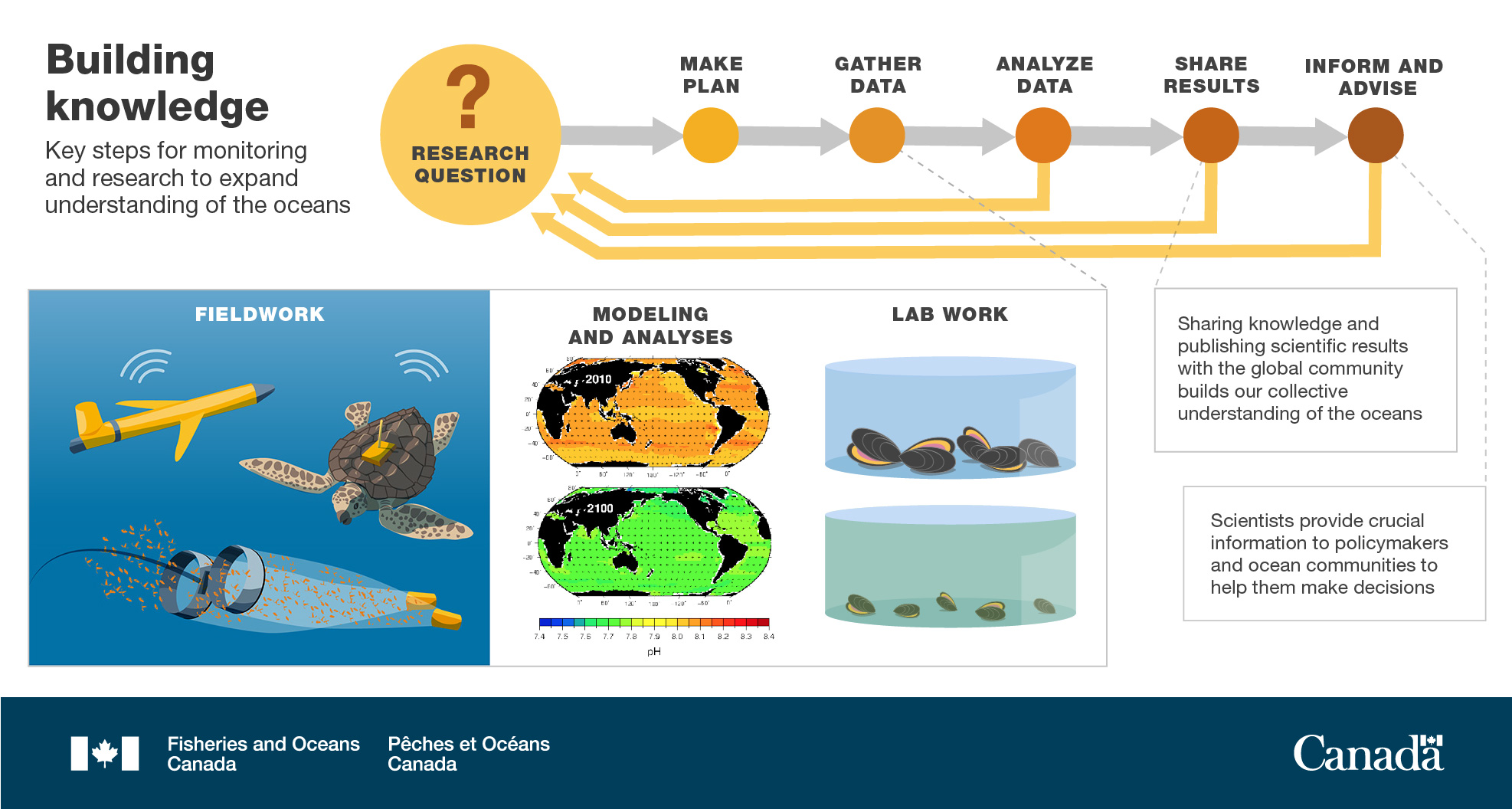
Figure 11: Scientists build knowledge and expand our understanding of Canada’s oceans through an continual process, using multiple tools and methods, for the benefit of all Canadians.
Monitoring and research programs set out to answer questions or resolve issues identified by regulators, stakeholders, and communities. The more collaborative the research objectives are, the more interests they can benefit.
Ocean science data is gathered in various ways. It may come from direct sampling or existing datasets, and collected from field sites, laboratories, or databases.
Ocean data analysis produces results that can inform ecosystem status and trends. Scientists may also develop computer models that can use past observations to predict future states of the ocean.
Sharing science through open data portals, scientific publications, or meetings and conferences is important to maintain the credibility and transparency of scientific activities. Access to this information can help with research or conservation plans by making it known to a broader audience.
Providing information and advice based on Canadian ocean science supports evidence-based decision making and the development of policies on fisheries and aquaculture management to marine protected areas—in Canada and abroad.
Knowledge gaps that are identified for species or ocean areas can influence future data collection efforts. New data may be collected or methods developed to gather information that is more accurate or detailed to fill gaps. This is how the research cycle continues and our knowledge expands.
Spotlight: Learning together
Each summer, one of Canada’s largest populations of beluga whales, estimated at about 40,000 individuals, visits the Mackenzie Estuary of the Beaufort Sea. For the past 40 years, scientists, community members, and co-management boards have worked together to study these whales through a unique, community-based harvest monitoring program., The program collects data to address community concerns about the Eastern Beaufort beluga population and identify areas for new or different research projects. Current interest is focused on beluga population status, their health, and food web linkages.
Over the past four decades, the program has grown to engage all six communities within the Inuvialuit Settlement Region. Collecting field samples, working on samples in the lab, and presenting findings at scientific conferences are jointly undertaken by government and Inuvialuit participants, including elders and youth.
In 2016, the first ever Beluga Summit was held in Inuvik, Northwest Territories, bringing together 80 participants from Inuvialuit Settlement Region communities, government, and academia. The summit explored the status of the belugas and created an environment of dialogue, discussion, and learning where Inuit knowledge and science were equally valued and respected.
- Date modified:
